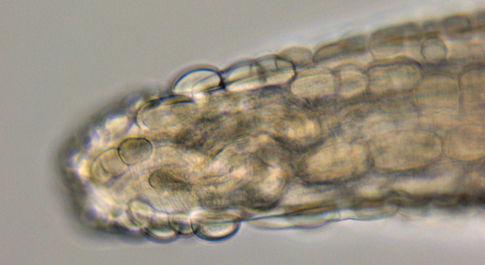Buddy: The worm that launched a million ‘icks’
Jon Allen took stock of the situation over the holiday break. His colleague Oliver Kerscher gave him some surprising numbers. Allen’s wife, the science writer Margaret Pizer, had some more numbers, equally surprising.
The numbers all had to do with Buddy, the unwelcome guest that Allen found living inside his own mouth half a decade ago. Allen’s discovery and nocturnal eviction of Buddy was the subject of an Animal Planet “Monsters Inside Me” dramatization that aired in fall, 2017.
Buddy, the worm, died in December, 2012, shortly after Allen peered into his bathroom mirror (with Pizer holding a flashlight) and fished the nematode out of his cheek with a set of #5 super-fine-tip forceps.
The worm may be no more, but Buddy, the legend, lives on in social media.
From the beginning, there was considerable media interest in the idea of a parasitic worm inhabiting the mouth of an invertebrate biologist — Allen is an associate professor in William & Mary’s Department of Biology. Tamara Dietrich of the Daily Press wrote a story, and Pulitzer Prize-winner Deborah Blum did a piece for Wired.
 The folks at Animal Planet were interested, too. Their episode “Biologist Removes Parasite from his Own Mouth” continues to draw attention.
The folks at Animal Planet were interested, too. Their episode “Biologist Removes Parasite from his Own Mouth” continues to draw attention.
“Based on my calculations about 15 people have watched the video since I started typing this email,” Allen wrote. Kerscher, also a biologist at William & Mary, let Allen know that the Animal Planet’s promo video has logged millions of views on YouTube.
“I had no idea of its popularity until Oli (Kerscher) mentioned it, so I’m glad someone is paying attention!” Allen wrote. “Margaret says there are nearly a million more views of the video on Facebook, though frankly I don’t really know what that means in terms of unique viewers.”
Social-media interest in Buddy continues to mount. On New Year’s Day, the YouTube promo (posted in November) logged 4,464,227 views. Buddy has logged nearly 400,000 additional views since then.
Animal Planet’s Facebook page reported 934k views of the promo on Jan. 1. There were 174 shares and a reaction log of 1.2k, which included 28 inexplicable “Loves,” as well as a long slate of comments that contained a predictably large number of references to a certain Signourney Weaver sci-fi movie.
{{youtube:medium|AmNid7KxUhU, Buddy stars in "Monsters Inside Me"}}
The promo, like the segment, intercuts reenactments with interviews of the actual participants in the saga of Buddy. Once Allen had wrestled Buddy out of his cheek, he put the worm in a container of his saliva and took Buddy to his lab — still in his pajamas. (Allen — not the nematode.) He collaborated on a paper with Kerscher’s wife, Aurora Esquela-Kerscher, a researcher at Eastern Virginia Medical School.
They were able to identify the species of worm, a parasite that usually infests livestock. Their paper, “Gongylonema pulchrum Infection in a Resident of Williamsburg, Virginia, Verified by Genetic Analysis,” was published in the American Journal of Tropical Medicine and Hygiene.
Esquela-Kerscher also named the worm: “He’s your buddy, Jon. So his name is Buddy!”
Their paper was a solid contribution to science and Allen is only the 57th known human to be a host of Gongylonema pulchrum. He and Esquela-Kerscher believe the incidence is underdiagnosed, though.
Allen has mixed feelings about all the interest that the saga of Buddy continues to draw. It’s gratifying, but he understands that a “yuck” aspect drives it, rather than sudden public interest in invertebrate science.
“Honestly, I’m much more excited that nearly 150 people have watched our video of Crown of Thorns Seastars ‘hopping’ in Australia, from our recent trip there,” he said. “Much cooler biology if you ask me!”
















